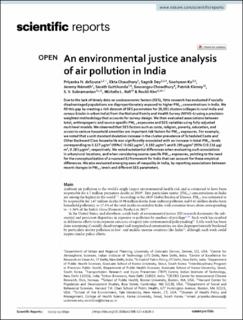An environmental justice analysis of air pollution in India
| dc.contributor.author | deSouza, Priyanka N. | |
| dc.contributor.author | Chaudhary, Ekta | |
| dc.contributor.author | Dey, Sagnk | |
| dc.contributor.author | Ko, Soohyeon | |
| dc.contributor.author | Németh, Jeremy | |
| dc.contributor.author | Guttikunda, Sarath | |
| dc.contributor.author | Chowdhury, Sourangsu | |
| dc.contributor.author | Kinney, Patrick | |
| dc.contributor.author | Subramanian, S.V. | |
| dc.contributor.author | Bell, Michelle L. | |
| dc.contributor.author | Kim, Rockli | |
| dc.coverage.spatial | India | en_US |
| dc.date.accessioned | 2024-03-06T13:51:40Z | |
| dc.date.available | 2024-03-06T13:51:40Z | |
| dc.date.created | 2023-11-07T11:20:54Z | |
| dc.date.issued | 2023 | |
| dc.identifier.citation | Scientific Reports. 2023, 13 (1), . | en_US |
| dc.identifier.issn | 2045-2322 | |
| dc.identifier.uri | https://hdl.handle.net/11250/3121314 | |
| dc.description.abstract | Due to the lack of timely data on socioeconomic factors (SES), little research has evaluated if socially disadvantaged populations are disproportionately exposed to higher PM2.5 concentrations in India. We fill this gap by creating a rich dataset of SES parameters for 28,081 clusters (villages in rural India and census-blocks in urban India) from the National Family and Health Survey (NFHS-4) using a precision-weighted methodology that accounts for survey-design. We then evaluated associations between total, anthropogenic and source-specific PM2.5 exposures and SES variables using fully-adjusted multilevel models. We observed that SES factors such as caste, religion, poverty, education, and access to various household amenities are important risk factors for PM2.5 exposures. For example, we noted that a unit standard deviation increase in the cluster-prevalence of Scheduled Caste and Other Backward Class households was significantly associated with an increase in total-PM2.5 levels corresponding to 0.127 μg/m3 (95% CI 0.062 μg/m3, 0.192 μg/m3) and 0.199 μg/m3 (95% CI 0.116 μg/m3, 0.283 μg/m3, respectively. We noted substantial differences when evaluating such associations in urban/rural locations, and when considering source-specific PM2.5 exposures, pointing to the need for the conceptualization of a nuanced EJ framework for India that can account for these empirical differences. We also evaluated emerging axes of inequality in India, by reporting associations between recent changes in PM2.5 levels and different SES parameters. | en_US |
| dc.language.iso | eng | en_US |
| dc.publisher | Springer Nature ltd | en_US |
| dc.rights | Navngivelse 4.0 Internasjonal | * |
| dc.rights.uri | http://creativecommons.org/licenses/by/4.0/deed.no | * |
| dc.title | An environmental justice analysis of air pollution in India | en_US |
| dc.title.alternative | An environmental justice analysis of air pollution in India | en_US |
| dc.type | Peer reviewed | en_US |
| dc.type | Journal article | en_US |
| dc.description.version | publishedVersion | en_US |
| dc.source.pagenumber | 0 | en_US |
| dc.source.volume | 13 | en_US |
| dc.source.journal | Scientific Reports | en_US |
| dc.source.issue | 1 | en_US |
| dc.identifier.doi | 10.1038/s41598-023-43628-3 | |
| dc.identifier.cristin | 2193155 | |
| cristin.ispublished | true | |
| cristin.fulltext | original | |
| cristin.qualitycode | 1 |
Tilhørende fil(er)
Denne innførselen finnes i følgende samling(er)
-
Journal articles [468]

